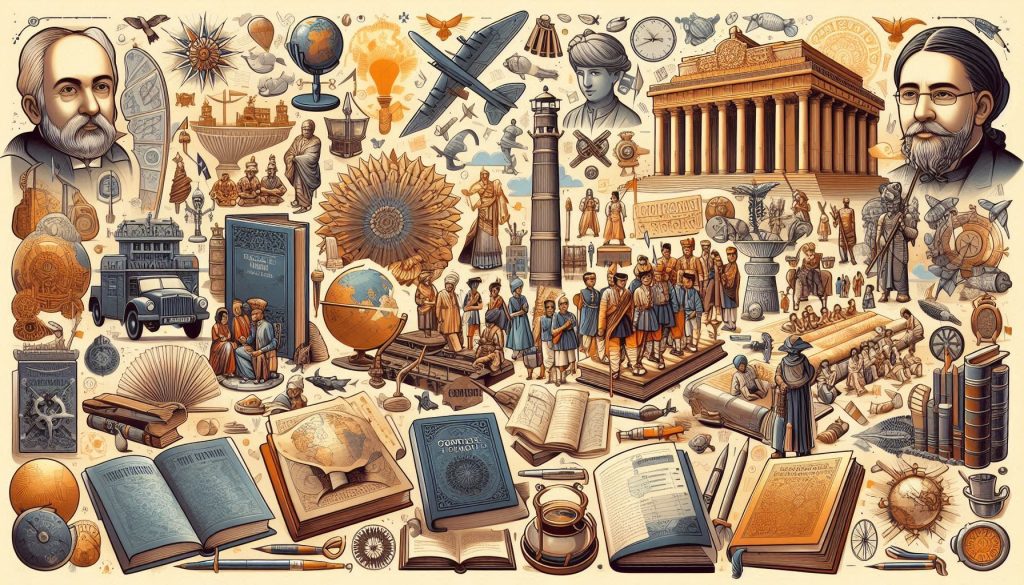Introduction – How When And Where- Complete Guide For Class 8th History Chapter 1

Our learning resources for the chapter, “Introduction: How When and Where” in History for Class 8th are designed to ensure that you grasp this concept with clarity and perfection. Whether you’re studying for an upcoming exam or strengthening your concepts, our engaging animated videos, practice questions and notes offer you the best of integrated learning with interesting explanations and examples.
The “Introduction: How When and Where” chapter gives a general overview of historical research with an emphasis on recognizing the importance of dates, events, and periodization. Important points in “Introduction: How When and Where” include how historiography has changed over time, moving from just listing dates to examining the causes and mechanisms underlying events, as well as the utilization of a variety of official and unofficial sources. This chapter “Introduction: How When and Where” is crucial because it establishes the framework for critical historical analysis, which enables us to understand the intricacies and dynamics of human history.
Objectives of the Chapter
Now that we know the importance of studying this chapter, let’s understand the objectives behind studying ‘Introduction: How When and Where’
- To understand the Importance of Dates
- To Analyze Historical Periodisation
- To Critically examine the British Classification of Indian History
- To Identify Diverse Historical Sources
Let’s now understand these objectives in detail.
How Important are Dates?
- Historical Focus on Dates: Traditionally, history was synonymous with dates, centering on the meticulous recording of significant dates and events.
- Detailed Records: Historians recorded dates for events such as battles, coronations, marriages, and deaths.
- Traditional Approach: The focus was on noting the dates when events occurred, including the dates of a king’s coronation or death.
- Modern Shift: Modern historiography has shifted from focusing solely on dates to understanding the reasons and processes behind these historical dates.
Now let’s understand the importance of periodization as outlined in the chapter “Introduction: How When and Where.”
How Do We Periodise?
- Periodization involves dividing history into distinct periods to identify and analyze the unique characteristics of each period.
- Each period is studied to capture the central features and developments specific to that period.
- This method helps in understanding the broader context of historical periods and the continuity or changes between different periods over time.
- By examining different periods, historians can assess how changes between periods influence overall historical developments.
Now that we understand the importance of periodization, let’s explore the classification of Indian history by James Mill from the British government that is explained in the chapter ‘Introduction: How When and Where’.
James Mill Classification of Indian History
- In 1817, James Mill, a Scottish economist and political philosopher, published “A History of British India,” where he introduced a classification of Indian history into three periods: Hindu, Muslim, and British.
- James Mill‘s classification reflected his belief that Asian societies were less civilized compared to Europe, showcasing a Eurocentric perspective.
- This classification by James Mill has had a lasting impact on the periodization of Indian history, shaping how historical periods were understood and categorized.
- The classification provided by James Mill influenced historical narratives and periodization for a significant period, emphasizing a European viewpoint on civilization.
- James Mill‘s classification of Indian history into Hindu, Muslim, and British periods remains a notable example of how historical classifications can reflect broader cultural biases.
- Many historians refer to the British period as the ‘Colonial’ period.
Let’s understand the ‘Colonial Period’ in detail.
What is Colonial?
- When one country’s colonial rule leads to political, economic, social, and cultural changes in another, this process is referred to as colonization.
- Colonialism in India refers to the British colonial conquest and subjugation of local Nawabs and Rajas.
- The British established colonial control over the economy and society, altering existing structures and practices.
- The British implemented colonial systems to collect revenue and buy goods at low prices, influencing local economies.
- Under colonial rule, the British produced crops specifically for export, affecting agricultural practices.
- The colonial period brought significant changes in values, tastes, customs, and practices due to British influence.
Let’s examine the ‘How Do We Know?’ section or the diverse historical sources that have been explained in the chapter ‘Introduction: How When and Where’.
Diverse Historical Sources
within the chapter How When and Where, there has been a mention of diverse historical sources which includes-
- Historians use various sources to write about the modern history of India, especially the last 250 years.
- The official records of the British administration are crucial sources, meticulously documenting every instruction, plan, and policy decision.
Now let us understand these sources in detail.
Official Records
- Official records of the British administration are crucial sources, meticulously documenting every instruction, policy decision, and investigation. These official records were systematically preserved in record rooms attached to administrative institutions, making official records vital for understanding colonial administration.
- The thorough documentation found in official records offers detailed and organized accounts of administrative actions and decisions. As primary sources, official records are indispensable for historians studying the governance and policies of the British colonial period.
Surveys
- Surveys conducted under colonial administration are essential sources for mapping and understanding various aspects of India, including topography, soil quality, and cropping patterns.
- These surveys were designed to gather comprehensive data, making surveys important for analyzing the geographic and economic conditions of the time.
- Additionally, surveys include census operations, which were held every ten years and provide detailed records of population demographics, castes, religions, and occupations.
- These survey sources are critical for understanding social and economic structures during the colonial period.
Unofficial Records
- Unofficial records, such as diaries and autobiographies, offer personal insights and perspectives that official records may not capture. These unofficial records are valuable sources for understanding the lived experiences and personal views of individuals during historical events.
- Unofficial records also include accounts of pilgrims and travelers and newspapers, which provide alternative viewpoints and cultural contexts that enrich the historical narrative. These unofficial records help historians explore diverse experiences and opinions beyond official documentation.
In conclusion, Class 8 History Chapter 1, “Introduction: How When and Where,” lays the foundation for understanding the essential aspects of historical inquiry. This chapter emphasizes the significance of dates, historical periodization, and the importance of various sources, both official and unofficial. By exploring “Introduction: How When and Where,” students gain insight into how history is recorded, interpreted, and classified, particularly during the colonial period. With the help of our learning resources, understanding “Introduction: How When, and Where” becomes easier and more engaging, ensuring that students grasp the core concepts of historical research with clarity and depth.
Practice questions on Chapter 1 - Introduction - How When And Where
Get your free Chapter 1 - Introduction - How When And Where practice quiz of 20+ questions & detailed solutions
Practice Now








